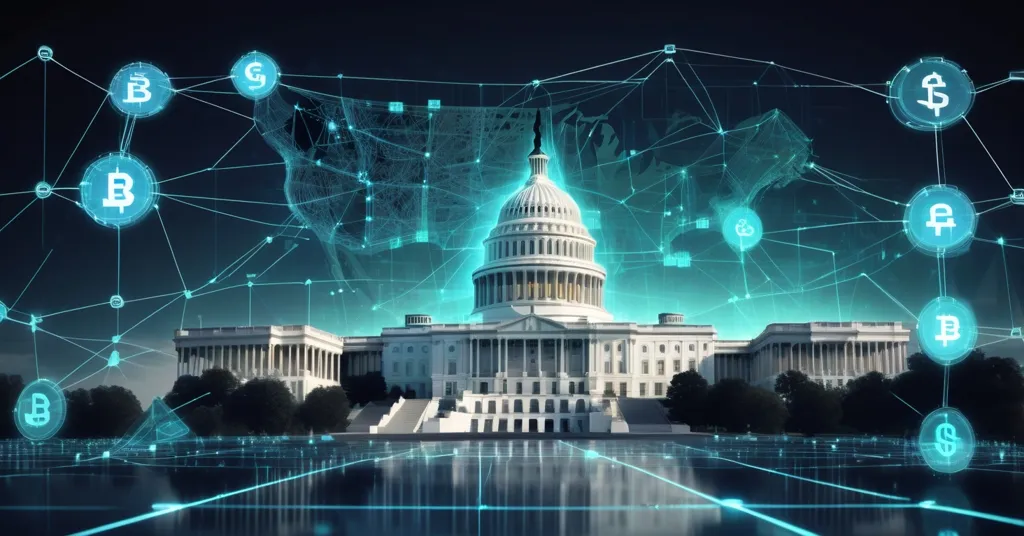US Government to Put GDP Data on Blockchain: Transparency Breakthrough or Risky Move?

US Government to Publish Economic Data on Blockchain: Transparency or Tech Overreach?
The United States government is making a seismic shift by planning to publish critical economic statistics, like GDP data, directly on the blockchain. Spearheaded by the Department of Commerce, this initiative promises unparalleled transparency and data integrity at a time when trust in centralized systems is at an all-time low. But is this a revolutionary step forward or a risky experiment with unproven tech?
- Groundbreaking Move: U.S. to release GDP and economic stats on blockchain.
- Transparency Aim: Designed to prevent tampering and modernize data access.
- Political Backing: Tied to Trump’s pro-crypto agenda and regulatory reforms.
A Historic Leap for Data Integrity
In a recent White House Cabinet meeting, Commerce Secretary Howard Lutnick dropped a bombshell that could redefine how we trust public data. Speaking directly to President Donald Trump, whom he dubbed the “crypto president,” Lutnick announced that the Department of Commerce will begin issuing key economic indicators, starting with GDP, on a blockchain. This isn’t just a tech gimmick—it’s a calculated effort to ensure data can’t be manipulated, offering a tamper-proof ledger for information that drives global financial decisions. For more on this announcement, check out the latest updates on why this matters.
“The Department of Commerce is going to start issuing its statistics on the blockchain because you are the crypto president. And we are going to put out GDP on the blockchain so people can use the blockchain for data distribution.”
For those just stepping into this space, blockchain is a decentralized, unchangeable digital ledger. Picture it as a public diary where every entry is locked with a key everyone can see but no one can alter. First popularized by Bitcoin, this tech ensures transparency by spreading records across countless computers instead of a single, potentially vulnerable server. When applied to something as vital as Gross Domestic Product (GDP)—a snapshot of a nation’s economic health that impacts everything from job markets to tax rates—it means analysts, investors, and everyday folks can access raw, verified numbers in real time. No more delayed reports or whispers of insider tweaks; the data is out there, immutable and unfiltered. Learn more about the basics of blockchain technology for government data.
Legislative Muscle and Political Will
This isn’t a rogue experiment by a lone agency. It’s backed by serious policy moves, notably the Deploying American Blockchains Act of 2025 (H.R. 1664), which sailed through the House in June and awaits Senate approval. This bill anoints the Commerce Department as the spearhead for blockchain policy, showing the U.S. is fully committing to decentralized tech. On top of that, a January 2025 executive order from the Trump administration pushed federal agencies to fast-track digital asset innovation and craft favorable regulations. Trump’s vision, echoed by SEC Chairman Paul Atkins, is bold: position America as the “crypto capital of the world.” They’ve even cracked open 401(k) retirement accounts—a staggering $8.7 trillion market as of early 2025—to crypto investments, signaling a monumental pivot toward mainstream adoption. Dive into the specifics of the Trump administration’s crypto policy and SEC initiatives.
But the Commerce Department isn’t flying solo. Other federal giants, including the Treasury Department, Fiscal Service, and Department of Defense, are exploring blockchain for tracking government spending and securing supply chains. Meanwhile, the SEC is rolling out “Project Crypto,” a sweeping effort under Atkins to update securities regulations and clarify the murky waters around digital assets. Dropping investigations into major players like Coinbase and Uniswap marks a sharp U-turn from past crackdowns that shoved crypto firms overseas. Legislative wins like the GENIUS Act, signed into law on July 18, 2025, further cement a government finally syncing with innovation rather than stifling it. For deeper insights, explore the Department of Commerce blockchain initiative details.
Global Context: Catching Up or Leading the Charge?
While the U.S. is making waves, it’s not the pioneer in blockchain for public data. Estonia has been at it since 2016, using Guardtime’s KSI blockchain to secure e-Health records and digital IDs, reportedly preventing countless data breaches. The European Blockchain Services Infrastructure (EBSI), launched in 2018, facilitates cross-border services with millions of transactions annually. Even within U.S. borders, California digitized 42 million car titles on the Avalanche blockchain in 2024. These cases prove the tech works for government use. But when the world’s largest economy puts GDP data on-chain, it’s not just an upgrade—it’s a geopolitical flex. This could force other nations to follow or risk appearing shady by comparison. Real-time, verifiable economic stats could reshape capital flows, interest rates, and policy decisions worldwide. The stakes couldn’t be higher.
Challenges: Not All Sunshine and HODL Memes
Before we pop the champagne, let’s face the ugly truth. Rolling out blockchain for federal data is a logistical nightmare. Integrating with legacy systems—think ancient COBOL-based databases still creaking along in government offices—is like fitting a Tesla engine into a Model T. Scalability is another beast; GDP data might be manageable, but tracking every federal expenditure on-chain could choke even the best networks. Lutnick himself hinted at a phased rollout, starting small with GDP and “ironing out details” before expanding. Translation: brace for glitches, delays, and a whole lot of head-scratching. For a discussion on how blockchain can address such challenges, see how blockchain ensures transparency in economic data.
Then there’s the privacy paradox. Blockchain’s strength is its transparency, but what happens when granular economic data reveals strategic weaknesses or sensitive trends? Without robust encryption or zero-knowledge proofs (a fancy way of proving data is true without showing the data itself), this openness could be a double-edged sword. And let’s be real—public understanding of blockchain is abysmal. Most folks might think “blockchain” sounds like a new CrossFit trend, not a trust mechanism. Convincing the average Joe to trust this over a government PDF will take serious education efforts, something the feds haven’t exactly mastered.
Political Risks and Centralization Concerns
There’s a political undercurrent here that’s hard to ignore. Tying this to Trump’s “crypto president” branding—and the messy fallout with Elon Musk, whose D.O.G.E. Department idea for on-chain spending data flopped—turns this into more than a tech story. It’s about legacy. What happens if a future administration lacks this crypto zeal? Policy flip-flops aren’t new, and blockchain integration isn’t a quick fix; it’s a decades-long commitment. Playing devil’s advocate, there’s also the risk of irony: a government-run blockchain could end up as a permissioned, semi-centralized system, not the decentralized utopia Satoshi dreamed of. If the feds control the nodes or pick a private chain, are we just swapping one overlord for another? Community reactions to these concerns can be found on platforms like Reddit discussions about US GDP data on blockchain.
Even the SEC’s newfound friendliness via “Project Crypto” comes with caveats. Atkins is pushing for “swift” regulatory proposals, but rushed rules often mean sloppy outcomes. We’ve seen regulatory whiplash before—hell, look at the “Operation Chokepoint 2.0” debacle that kneecapped crypto firms a few years back. If this turns into another half-baked policy mess, it could undermine the very innovation it’s meant to foster.
Future Potential: Disruption Worth Rooting For
Despite the hurdles, the upside is hard to dismiss. If executed well, on-chain economic data could be the gateway to deeper financial system integration. Atkins envisions capital markets running on blockchain, where tamper-proof stats boost investor confidence overnight. Algorithmic trading could get a nitro boost from real-time, verified inputs. For Bitcoin maximalists like us, this echoes the core principles of decentralization and trustlessness that birthed BTC—even if it’s not Bitcoin itself powering the ledger. And let’s not forget the wider crypto ecosystem: protocols like Ethereum or Avalanche, with their smart contract prowess, could fill niches Bitcoin doesn’t, like complex public data systems. Each chain has a role in this financial revolution. For a broader perspective, read about the impact of blockchain on government transparency and GDP data.
But we’re not here to peddle moonshot fantasies or shill baseless hype. This is a slow grind, a foundational step that might take years to bear fruit. If the government fumbles this with garbage tech or zero public education, it could torch blockchain’s credibility before it gets a fair shake. We’re cheering for disruption, but we’ll call out the bullshit if this turns into another overhyped federal flop.
What’s Next for Blockchain in Government?
The immediate horizon involves Senate review of the Deploying American Blockchains Act and Lutnick’s phased rollout starting with GDP data. Agencies like the Treasury and Defense are also in the early stages of their blockchain pilots. How these pieces come together—and whether public trust follows—will shape the next chapter. We’re watching with hawk eyes, ready to see if this sparks the mainstreaming of decentralized tech or just becomes another cautionary tale.
Key Questions and Takeaways on Blockchain Economic Data
- Why is the U.S. putting GDP data on blockchain a big deal?
It’s a historic first for a federal agency, promising unmatched transparency and data integrity while potentially setting a global standard for economic reporting. - How does this fit into Trump’s broader crypto push?
It aligns with executive orders, laws like the GENIUS Act, and SEC initiatives like Project Crypto, all aimed at making the U.S. a leader in digital assets and blockchain tech. - What roadblocks could derail this initiative?
Technical integration with outdated systems, scalability limits, privacy risks, and public skepticism could slow or sabotage adoption if mishandled. - Could on-chain economic data shake up global markets?
Yes, tamper-proof, real-time stats could enhance investor trust and influence capital flows or policy decisions, provided the rollout avoids major hiccups. - Are other countries ahead in blockchain for public data?
Absolutely—Estonia and Europe’s EBSI have proven track records, but the U.S. move carries unique weight due to its economic dominance and geopolitical clout.
So, where does this leave us? The U.S. government’s blockchain gamble is a thunderclap for advocates of decentralization and a challenge to skeptics still doubting the tech’s staying power. It’s a shot at rebuilding trust in public data when centralized systems face relentless scrutiny. But execution is everything—screw this up, and it’s not just a missed opportunity; it’s a setback for the entire space. For now, we’re rooting for a future where transparency isn’t just a buzzword, while keeping our eyes peeled for any whiff of incompetence. This is only the opening act, and the crypto world is watching.



